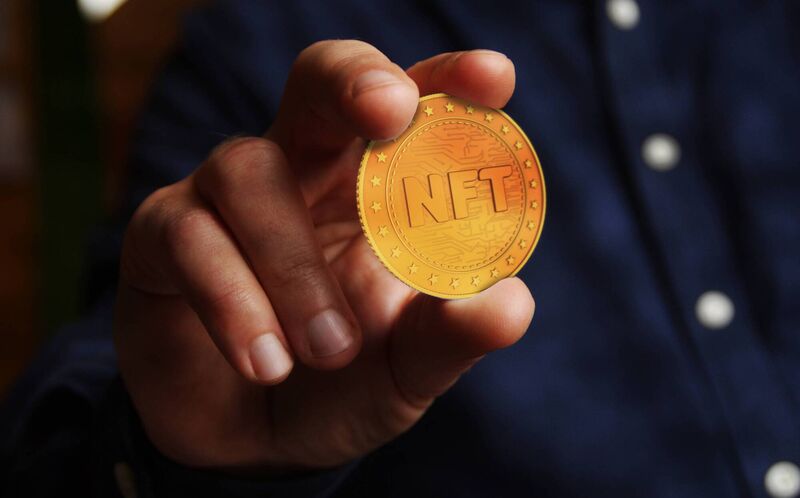Those are two phrases you may wish to be conversational with if you’re to have any opinion on the impenetrable phenomenon that is the Non-fungible token (NFT). They’re the popular soundbites used by celebrities to promote their latest must-have version of the cyber craze sweeping the planet.
NFTs have been around for some time, but have seen an explosion in popularity over the course of the past 18 months, aligned with the rise of cryptocurrencies — digital money in which transactions are monitored and verified by users, as opposed to a financial authority like a central bank — and metaverses — 3D virtual worlds, reignited as a buzzword via the endorsement of Facebook’s Mark Zuckerberg.
Suddenly everyone seems to want to launch an NFT.
If you’re feeling uninitiated, you could do worse than have a look at it girl Paris Hilton’s appearance on American late night host Jimmy Fallon’s in January.

The two discuss “buying an ape”, before Fallon produces said piece of artwork — a nondescript cartoon of said primate (Bored Ape is a growing brand — there are now 10,000 such NFTs, with Fallon having paid $200,000 for one of them) in a biker hat and shades.
Yes they are, although such an example is probably emblematic of NFTs at their least original. Celebrities across the spectrum, including some notable current and former footballers like former Chelsea and England captain John Terry, have been falling over themselves to produce NFTs of their own and, yes, many of them are via the medium of ape-art, which really seems to have caught on for some reason.
So what on earth is an NFT? Fungibility basically means an item is exchangable and replacable with an identical item — a €5 note say is fungible — it is immediately exchangable for another €5 note.
Non-fungible indicates that an item (it doesn’t have to be digital artwork, though that is where much of the emphasis to date seems to have gone) is unique, and non-exchangeable. These tokens exist on a unique digital ledger known as a blockchain, in the same manner as cryptocurrencies.
As they are non-exchangeable, their value is speculative — they are worth whatever someone else is willing to pay for them. And where you get speculation, you get the hope of profit.
At present, NFTs can only be purchased via cryptocurrency, primarily the Ethereum (a type of blockchain) variant. The real world value of a single Ethereum is currently in the region of €2,900.
While the idea behind the tokens may be somewhat opaque, the enthusiasm for them is undeniable when you consider the eye-watering sums of money being spent. In the first two weeks of January alone, OpenSea, the largest online NFT marketplace, reported $3.5bn (€3.2bn) in sales.
There are (slightly) more practical applications for NFTs — basketball’s governing body in the US the NBA has been marketing key “moments” from the sport, known as Top Shot, with some success, although those particular tokens were available for purchase with regular dollar currency.
The absurdity of NFTs however, in an ape artwork sense say, is that while a non-fungible token may be unique, the copyright of the image is not held by the NFT’s owner. So someone willing to pay millions for a crude drawing of an ape will essentially be in the same position as someone who takes a screenshot of the image off the internet.

But willing they are, and not always with positive results. Probably the most notorious NFT sale to date saw the former CEO of Twitter Jack Dorsey’s first tweet, or the NFT representation of same, bought for $2.9m in 2021 by Iranian cryptocurrency investor Sina Estavi.
Estavi put the same token up for sale last week, at a guide price of $48m, 16 times what he had paid for it.
The auction closed with just seven offers — the highest of which was for just $277.
Similarly, Liverpool FC launched a series of NFTs of their first-team players in recent months. A six-day auction at the beginning of April saw just 9,721 of the 171,000 NFTs sold. The football club had launched the scheme with a claim that it could be worth $11.2m but the revenue is estimated to be closer to $1m.
Also of note is the case of digital artist Mike Winkleman, otherwise known as Beeple, who last month sold an NFT of a collage he created for a frankly-bonkers $69m (€64m). Before last October, Winkleman had never sold a print for more than $100.
Why is this happening?
“What you are seeing is people who are desperate for profit looking for explosive returns,” said Brian Lucey, professor of international finance at Trinity College Dublin.
“They haven’t shown a single economic reason as to why there will be a future yield,” Prof Lucey said, adding the logic of NFTs requires “a pyramidial structure”. A glorified pyramid scheme in other words.
“With no underlying asset you’re totally reliant on an ever-increasing number of people seeing these things as valuable, and generally speaking they aren’t,” Prof Lucey added.
Our NFT advice? A storm best avoided.




